Shanghai Natural History Museum
By Xiaoyi Cai (Mia) Date: 2/23/2022

Architecture & Surrounding Environment
The much anticipated Shanghai Natural History Museum, designed by Perkins+Will’s Global Design Director Ralph Johnson, has opened in Shanghai. The 44,517 square meters (479,180 square feet) museum offers visitors the opportunity to explore the natural world through the display of more than 10,000 artifacts from all seven continents. The building includes exhibit spaces, a 4D theater, an outdoor exhibit garden, and a 30-meter tall atrium that welcomes visitors with an abundance of natural light filtered through a striking glass wall inspired by the cellular structure of plants and animals.
— An Iconic Cell Wall
There are three layers to the wall, each with its own geometrical pattern and organic form. It is structured in the shape of an elliptical cone that encircles the atrium. The organic cell is emphasized as nature’s structural building component in the main structural layer. The glass and aluminum mullion curtain wall form an interior layer that serves as the building’s waterproof envelope. The outer layer is a solar screen that functions similarly to traditional Chinese window screens and mimics the cellular building block of all life forms.

— Three Façades
The museum’s content is reinforced by the three primary façade designs. The cellular structure of plants and animals is related to the central cell wall. The vegetation on the earth’s surface is represented by the eastern living wall. Shifting tectonic plates, as well as river-eroded canyon walls, are suggested by the northern stone wall.
The underground garden and water feature serve as a focal point for the entire structure, bringing diffused daylight into public and circulation rooms and aiding visitor navigation.
 The LEED Gold-certified China Green 3-Star museum is a bioclimatic building that responds to solar radiation by using an appropriately oriented intelligent building skin to maximize daylight and minimize solar gain. The pond in the oval courtyard provides evaporative cooling while the temperature of the earth provides heating and cooling by using a geothermal system. All of the energy features of the museum are part of exhibits that explain the story of the museum.
The LEED Gold-certified China Green 3-Star museum is a bioclimatic building that responds to solar radiation by using an appropriately oriented intelligent building skin to maximize daylight and minimize solar gain. The pond in the oval courtyard provides evaporative cooling while the temperature of the earth provides heating and cooling by using a geothermal system. All of the energy features of the museum are part of exhibits that explain the story of the museum.

Last but not least, I want to emphasize its harmony with the surrounding environment. The museum spirals out of the ground and becomes an integral part of the larger parkland area.
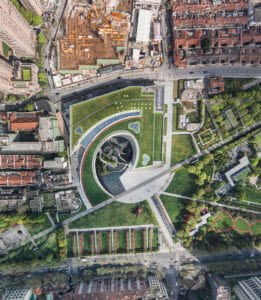
Museum Experience
As the professor had already booked our trip, we could easily swap the ID card to get into the museum, which is very convenient. And just at the left hand of the entrance, there were many brochures set aside with both Chinese and English versions.

The brochure contained much useful information that was necessary for a better museum experience, such as recommended itineraries, recommended highlights, floor guides, etc.
The museum’s 240,000 samples include roughly 62,000 animal specimens, 135,000 plant specimens, 700 Stone Age specimens, and 1,700 mineral specimens. A Yellow River mammoth, a gigantic salamander, a massive panda, and a Yangtze Alligator are just a few of the rare species found solely in China.
A four-story-high 140-million-year-old Mamenchisaurus hochuanensis Young et Zhao skeleton from Sichuan Province is the most striking exhibit. The museum also has two mummies and several human embryos on display.
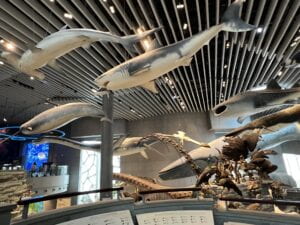
The Shanghai Natural History Museum’s major theme is “Nature • Humans • Harmony.” The Museum has ten permanent exhibits: Mysterious Beginnings, River of Life, Ways of Evolution, Earth Treasures, Colorful Life, Ecological Diversity, Survival Skills, Tied to Earth, Shanghai Environs, and Future Pathways, with three main threads running through the whole: “The Symphony of Evolution,” “The Picture Scroll of Life,” and “The Historical Epic of Civilization.” Over 11000 specimens and models from all seven continents are on display, with roughly a thousand specimens of uncommon species among them. A large-scale specimen display called “A Meeting Across Space and Time” brings together over 200 flora and fauna celebrities from past and present, China and abroad; a walk-in scene of almost 1500 square meters recreates the pulsating “African Savannah,” a large-scale specimen a display called “A Meeting Across Space and Time” brings together over 200 flora and fauna celebrities from past and present, China and abroad; The Cretaceous Escape Theater, as well as four other immersive theaters, depict significant evolutionary events. 26 “Window of Nature habitat boxes respect a natural history museum’s customary exhibition obligations; In the current media age, the audience is served with 400 visual devices and one online museum system. 1500 scientific drawings displayed in front of a live audience to demonstrate the merging of art and science; Nature is within easy reach thanks to a 300-square-meter live cultivation space; 1200 square meters of “Exploration Labs” furnish a paradise for observation and discovery, hands-on experiments and talk and discussion; a 4D theater with 180 seats provides an immersive sensory experience which comes at you from all sides: an Epic of Nature” multimedia show offers an artistic banquet where science and technology and the humanities are combined.
There are many interesting displays for the exhibitions in Shanghai Natural History Museum.
The most frequently seen is the combination of one group of specimens that the specimens of the same species will be put together with their typical movements, which enables the specimens to be more vivid and realistic. Also, the surrounding environment is imitated the original places where those species live.


As for the skeleton, they will be either arranged in a 3D or 2D model.


(3D example) (2D example)
Interestingly, there are many skeletons that are set only with head skeletons/ horns, which is extremely impressive.

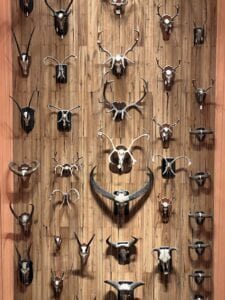
Furthermore, some of the specimens are displayed in half-complete versions, which shows the viscera of the animal.



For the insect and reptile specimens, they are all put in glass boxes. The boxes are arranged at a proper height so that even kids can easily see the specimens inside.


There are many living animals presented in the museum, and most of them are reptiles and fish. The museum provides them with a very comfortable environment to live in.


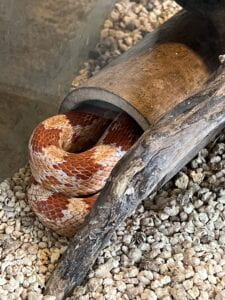

Despite those still displays, there are many interactive and immersive installations in the museum.
Those three dinosaurs can suddenly utter horrible sounds of dinosaurs’ sounds, which is truly frightening and gives the audience a real atmosphere and feelings for seeing the dinosaurs.
Another adorable immersive installation is a room imitating the environment of the deep sea with groups of various fish rushing through.

Another thing that I want to highlight is the light in the ore exhibits, which brings out the beauty and luster of the ore.
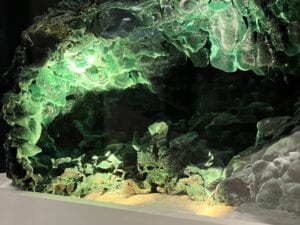
There was an exhibit that impressed me greatly, which displays various kinds of birds “flying” together.

First of all, all of the bird specimens here are very exquisite that are really similar to the real ones. Moreover, the setting for those birds are also very interesting that some of them are flying, some of them are standing at the slope, and some of them are seem to be catching the fish, imitating the vivid life of the birds. The design of slope was also fascinating that the designer put the waterline on it, which made it resembles the shallows where the birds like.
In general, the overall experience in Shanghai Natural History Museum was pretty engaging, and gave me plenty of inspiration for the ideas of diaroma. I will use two words to describe the museum: modern and vivid, because the design of the whole Shanghai Natural History Museum is quite up-to-date, giving people the novel atmosphere. Furthermore, as most of the exhibits in the museum are specimens that are made to be realistic, and their combination with imitated real environment makes people can truly get the vibe of vividity from those specimens.
Audience
According to my observation, most of the audience are young people, such as students like us, and many parents and children. The reason they wanted to attend to this museum, in my opinion, was to learn more about the natural world and get more knowledge about the world and science. For each of the exhibits, the audience usually would not spend much time on them, just taking a glance and passing through, unless they met some impressive pieces.
Facilities
The guide map is quite easy for the audience to find the bathrooms.

This museum provides a souvenir shop beside it, however, in my opinion, the products sold in the shop is a little lack of originality, and most of them were from other brands, such as Jellycat, etc.
Improvement
I admired this museum for its architecture and collection, however there is still something that may be improved to assist the museum to give the audience better museum experience. The most obvious one is that it will be better to pay more attention on the production of some of the specimens that for now are a little bit shabby. For instance, the lion and leopard placed in the museum seems to be quite funny, and a little different from the real one, which may mislead the audience.


